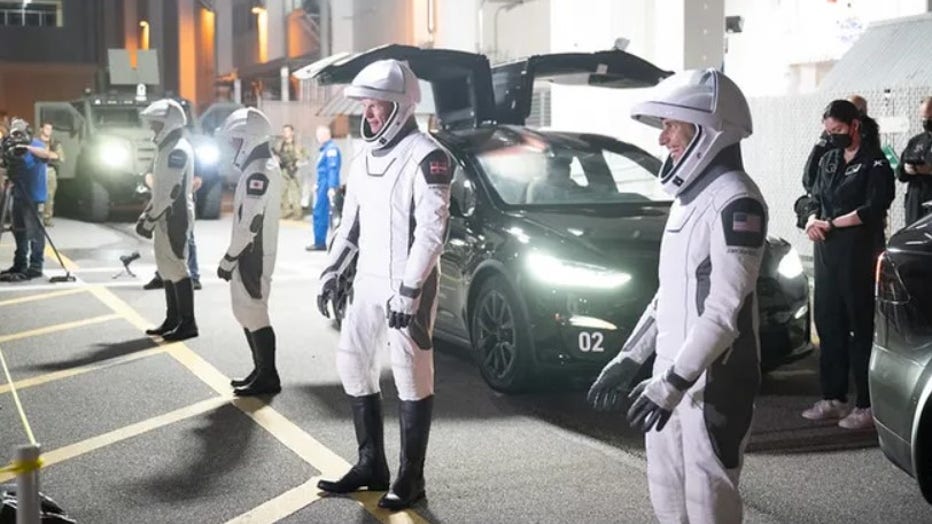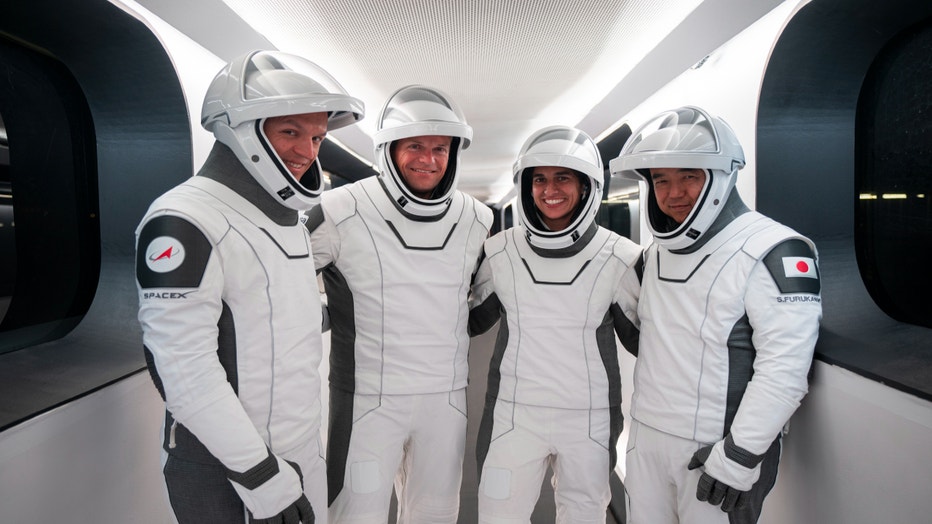NASA, SpaceX: Crew-7 bound for space station after successful Florida launch

NASA/SpaceX launch of Crew-7 mission
SpaceX and NASA successfully launched the latest crewed mission to the International Space Station. After a scrubbed launch attempt on Friday, it was ?all systems go? for an early Saturday morning liftoff of a Falcon 9 rocket Florida.
ORLANDO, Fla. - SpaceX and NASA successfully launched the latest crewed mission to the International Space Station.
After a scrubbed launch attempt on Friday, it was "all systems go" for an early Saturday morning liftoff of a Falcon 9 rocket from Florida, with an instantaneous launch window at 3:27 a.m.
Following stage separation, Falcon 9’s first stage returned to Earth on Landing Zone 1 (LZ-1) at Cape Canaveral Space Force Station, approximately eight minutes after launch.
The Dragon spacecraft supporting this mission previously flew NASA’s Crew-3 and Crew-5 missions to and from the space station.
Meet the Crew-7 astronauts
This is the first time that a NASA/SpaceX mission includes astronauts from four different space agencies. Previous commercial crew missions have included at least two NASA astronauts.
The crew is made up of mission specialist Konstantin Borisov, pilot Andreas Mogensen, commander Jasmin Moghbeli, and mission specialist Satoshi Furukawa.
NASA’s Moghbeli will lead the several-month-long mission with fellow teammates from Japan, Europe, and Russia. NASA said integrated crews are typical and ensure safe operations of the ISS continue through at least 2030.
NASA, the Canadian Space Agency, the European Space Agency, the Japan Aerospace Exploration Agency, and Roscosmos operate the station, with each space agency responsible for designated functions.
Here’s a closer look at each crew member who makes up the SpaceX Crew-7 mission.
Roscosmos Cosmonaut Konstantin Borisov
Borisov was the final member of the team of four to join the SpaceX Crew-7 mission. The launch will be the first for the Russian cosmonaut who started training in 2018. If the launch remains on schedule, Borisov will be one of four Roscosmos in space.
Sergey Prokopyev, Dmitry Petelin and Andrey Fedyaev are all aboard the ISS from previous missions.
As a mission specialist, Borisov will be tasked with conducting experiments and other functions.
"The main inspiration for me is the motivation to develop yourself as a professional to the level sufficient for long-term space expeditions," Borisov previously told the United Nations Office for Outer Space Affairs. "The required level of knowledge, stamina, psychology, skills one has to develop brings you to a profession where you learn something new every day. And every day you are becoming one step closer, stronger and more capable of working and living in space."

NASA astronaut Jasmin Moghbeli, right, ESA (European Space Agency) astronaut Andreas Mogensen, Japan Aerospace Exploration Agency (JAXA) astronaut Satoshi Furukawa, and Roscosmos cosmonaut Konstantin Borisov, wearing SpaceX spacesuits, are seen as th
NASA Astronaut Jasmin Moghbeli
Moghbeli will be the only woman and U.S. astronaut aboard the August mission. The U.S. Marine Corps pilot was born in Bad Nauheim, Germany, but considers Baldwin, New York, to be home. Moghbeli has flown more than 150 combat missions, including over war zones, but the SpaceX Crew-7 mission will be her first venture into space.
ESA Astronaut Andreas Mogensen
Mogensen became the first Danish citizen in space in September 2015 and will become the first non-US pilot to operate a SpaceX spacecraft.
The 46-year-old is an aerospace engineer, and the SpaceX Crew-7 mission will be his second time at the ISS.
The European Space Agency has nicknamed its segment of the mission the "Huginn" and in addition to piloting, Mogensen is set to carry out numerous science experiments.
JAXA Astronaut Satoshi Furukawa
Japan’s Furukawa is the only member of the SpaceX Crew-7 mission who has been part of a long-duration stay aboard the ISS.
Furukawa previously served as a flight engineer aboard the space station during ISS Expedition 28-29 in 2011.
During the upcoming mission, Furukawa will serve as a mission specialist and be tasked with performing experiments and other functions aboard the ISS.
The SpaceX Crew-7 is expected to return to Earth sometime in early 2024.

NASA astronaut Jasmin Moghbeli, right, ESA (European Space Agency) astronaut Andreas Mogensen, Japan Aerospace Exploration Agency (JAXA) astronaut Satoshi Furukawa, and Roscosmos cosmonaut Konstantin Borisov, wearing SpaceX spacesuits, are seen as th
Crew-7 mission overview
After docking at the space station, Crew-7 will conduct several days of handover activities with the departing astronauts of NASA's SpaceX Crew-6 mission. After the handover period, NASA astronauts Stephen Bowen and Woody Hoburg, along with UAE (United Arab Emirates) astronaut Sultan Alneyadi, and Roscosmos cosmonaut Andrey Fedyaev of Crew-6 will undock from the space station and splash down off the coast of Florida.
According to NASA, Crew-7 will conduct research to prepare for human exploration beyond low Earth orbit, including the collection of microbial samples from the exterior of the space station, the first study of human response to different spaceflight durations, and an investigation of the physiological aspects of astronauts' sleep. These are just a few of the more than 200 science experiments and technology demonstrations that will take place during their mission.
While aboard the orbiting laboratory, Crew-7 will see the arrival of both the SpaceX Dragon and the Roscosmos Progress cargo spacecraft. Crew-7 also is expected to welcome the agency’s Boeing Crew Flight Test astronauts, the Axiom Mission-3 crew, and the first cargo flight of Sierra Space’s Dream Chaser during their expedition. The Soyuz spacecraft with three new crew members also is planned for launch during their stay, and the Soyuz carrying NASA astronaut Frank Rubio and Roscosmos cosmonauts Sergey Prokopyev and Dmitri Petelin will depart after 371 days on the station.
RELATED: Artemis II mission: Meet the 4 astronauts to make historic trip around the moon in 2024
The crew will spend about six months working and conducting research on the ISS. There will be 11 astronauts on the space station for a few days before the Crew-6 mission departs for Earth. Dragon Endeavor is set to undock with the four Crew-6 astronauts no earlier than Sept. 1.

